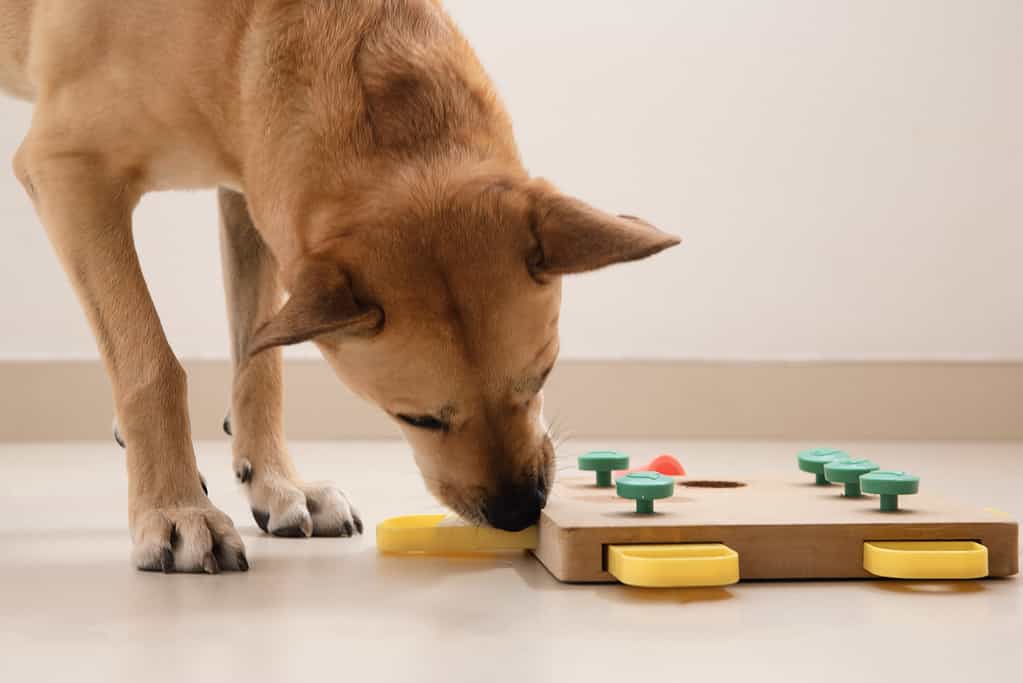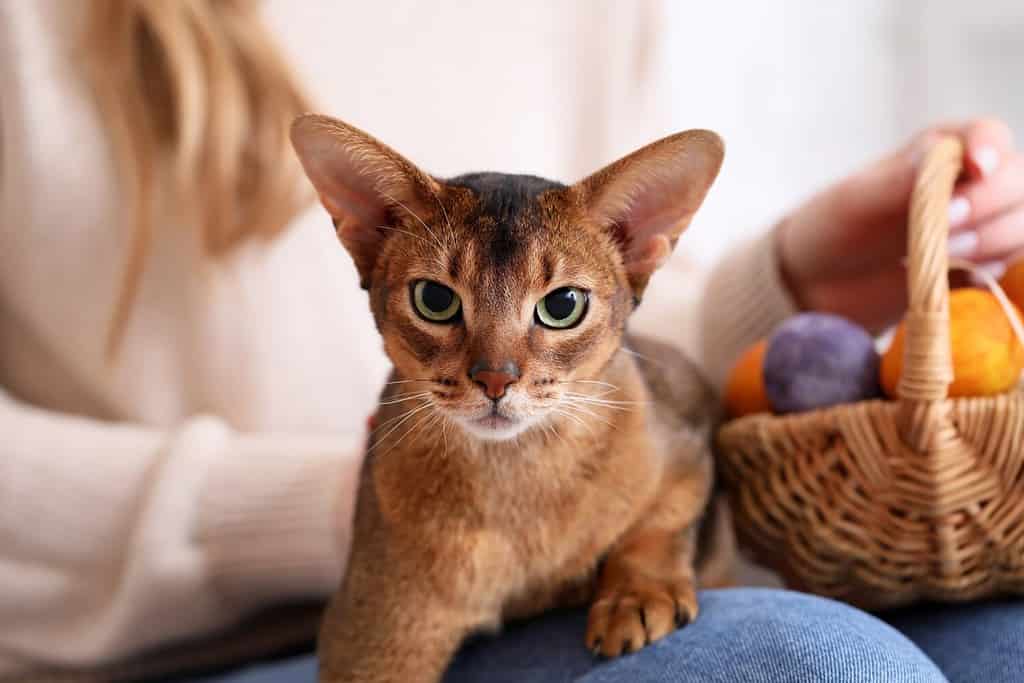
Certain cat breeds are capable of recognizing words, which they associate with actions or behaviors.
©Assja/iStock via Getty Images
Animal lovers recognize that their beloved pets are quite smart. Kitties and pups consistently surprise their owners by thinking creatively, remembering where treats are hidden, and finding ways to reach areas they are not supposed to.
Though we all agree both dogs and cats are smart in certain ways, the classic cat vs. dog debate is still ongoing in the pet community. Cats are known for their independence and reserved personalities. In contrast, dogs are happy to obey for a treat and commonly portrayed as easily manipulated animals.
Let’s attempt to put the argument to bed and finally determine whether cats are smarter than dogs.
Dog Intelligence

Dachshunds were bred for hunting and fetching prey in holes, making them possess average intelligence.
©Liliya Kulianionak/iStock via Getty Images
Dogs are “man’s best friend,” because they are happy to serve and will do anything for simple motivations, affection, and food. It is common for dog owners to train their dog in basic obedience and commands for the safety of their family and others around them. Dog schools are widely available.
Measuring Dog Intelligence – Commands
Measuring a dog’s intelligence is different from measuring a human’s IQ (intelligence quotient). Because dogs are bred to serve and work, their intelligence is measured by their ability to recognize, comprehend, and execute commands.
If a dog takes a long time to understand orders, they will score lower in their intellectual category. This also applies to dogs who are inconsistent in executing commands.
Dogs who can easily learn, understand, and execute a command quickly and consistently score high in intelligence.
Measuring Dog Intelligence – Problem-Solving
A dog’s ability to problem-solve heavily factors into their intelligence rating. Dogs have excellent senses and can detect familiar and unfamiliar things with precise accuracy. Depending on the breed, a dog’s ability to recognize familiar scents and find them or solve problems regarding those scents varies.
For example, hiding a treat under a blanket will determine if a Labrador can recognize objects not in direct view, understanding something is hidden. Alternatively, if the same Labrador can find a solution to reach a hidden treat, he will score well in problem solving.
Most Intelligent Dogs Breeds

Provide dogs with problem-solving food feeders to help reduce their caloric intake.
©Lenti Hill/iStock via Getty Images
Despite their dopey portrayal in modern media, dogs have a wide range of personalities and intellectual prowess. Not every dog breed is intellectually the same, with some breeds being smarter than others.
The most intelligent dog breeds are border collies, poodles, and German shepherds. These dogs are taught important commands and skills to help humans with vital jobs. For instance, German shepherds and Belgian Malinois are common breeds for security, police work, and search-and-rescue squads. Border collies are bred to be working dogs to herd livestock. Poodles undergo training to be emotional support animals.
Cat Intelligence

Cats will watch birds and squirrels on video, indicating they recognize animals.
©Yulcha/iStock via Getty Images
Throughout history, cats have had a mutually beneficial relationship with humans. Cats naturally deter vermin like mice and rats, reducing the risk of disease and crop damage. Their independent attitudes are commonly associated with higher intelligence, knowing what they want, and being willing to say no. But does this make them intelligent, or simply stubborn?
Measuring Cat Intelligence – Observation and Adaptation
Cats cannot have a specific numerical IQ because their intelligence level is measured through observation and adaptation. They are highly observant animals, constantly analyzing their surroundings and adapting to the flow of the environment.
Cats watch their owners and mimic their behaviors as a method of showing affection and reflecting appropriate behavior. The more a cat replicates their owner’s actions, mannerisms, and behaviors, the higher their intelligence.
Additionally, their ability to adjust to changes is a main intelligence factor. Cats that identify changes in the house, including emotional cues, and adjust their habits accordingly are more mentally aware than cats who maintain the same routines despite the changes.
Measuring Cat Intelligence – Problem-Solving

Many cats mimic their owners and replicate intelligent behaviors like organizing their toys.
©YURY KISIALIOU/iStock via Getty Images
Cats do not perform tricks as easily as dogs but are capable of solving similar problems. The previous example of hiding a treat will test a cat’s environmental awareness and object permanence.
If cats are accurately capable of identifying treats under a blanket or finding a way to reach the treats successfully, they will score higher in intellectual.
Measuring Cat Intelligence – Memory
Cats have an excellent memory. They are capable of remembering events, locations, and sensory influences, as well as the feelings they experienced during those events. Dogs are capable of remembering places as well, especially if they are associated with pleasant or traumatic events.
According to a study in 2017, cats are capable of remembering information after a single experience.
Smartest Cat Breeds

These breeds are the smartest because they are intellectually curious and capable of learning tricks.
©Pixel-Shot/Shutterstock.com
Like every other animal, not all cats are the same. Certain breeds are naturally more intellectually curious than others.
The most intelligent cat breeds are Abyssinians, Bengals, and Cornish rexes.
These breeds are the smartest because they possess a naturally independent, free-thinking mindset and are intellectually curious and capable of learning tricks and solving puzzles.
Summary of Gauging Cat and Dog Intelligence
Ultimately, cats and dogs are different animals and require different ways of analyzing their intellectual capabilities.
| Gauging Cat Intelligence | Gauging Dog Intelligence |
|---|---|
| Responding to name | Responding to name |
| Understanding differences in familiar and unfamiliar voices | Ability to learn, comprehend, and execute commands |
| Adjusting natural behavior to changes in surroundings | Successful consistency of executing commands on cue |
| Responding with emotional or physical cues to understand a situation | Rate of learning, comprehending and executing new commands |
| Object permanence | Identifying objects when not directly in view |
| Recalling information to solve problems or adjust behavior | Problem-solving with object permanence |
Are Cats Smarter Than Dogs
Unfortunately, it is not clear whether cats are smarter than dogs. It is an unfair comparison since they are unique animals with different levels of intellectual comprehension.
Dog intelligence is based on how well they follow commands, and cat intelligence is based on how well they observe and learn from their environments.
Some intelligent cat breeds like the Abyssinian are potentially smarter than some Afghan hounds, bulldogs, or Basenjis breeds. But Border collies and poodles could be smarter than Persians or Birman cats.
Overall, both animals have the average intelligence of a two-year-old human. The important lesson here is to understand that both animals are equally intelligent in their own ways. Cats are more independent, which is a trait associated with high intelligence, but dogs are just as intelligent due to their ability to learn and desire to follow commands.
The photo featured at the top of this post is © YURY KISIALIOU/iStock via Getty Images
Thank you for reading! Have some feedback for us? Contact the AZ Animals editorial team.






